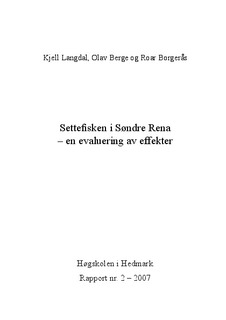Settefisken i Søndre Rena – en evaluering av effekter
Research report
Permanent lenke
http://hdl.handle.net/11250/133802Utgivelsesdato
2007Metadata
Vis full innførselSamlinger
Sammendrag
Norsk: Rapporten er en oppsummering av undersøkelser på settefisk og et forsøk på å evaluere effektene av utsettingene i Søndre Rena. Her inngår tre delprosjekter: 1) Forflyttning hos settefisk etter utsetting og effekt av akklimatisering i merd. 2) Hvor raskt og godt settefisken tilpasser seg forholdene i det fri. 3) Hva settefisken har bidratt med til fisketilbudet i Søndre Rena. Umiddelbart etter utsetting foretar settefisken kortere eller lengre forflyttninger nedstrøms og alle er stasjonære etter 14 dager. Noen settefisk havner i Løpsjøen og blir etter hvert borte. En blir funnet igjen i en gjeddemage, de øvrige har ukjent skjebne. Akklimatisering i en merd i 48 timer i forkant av utsetting gav ingen dokumenterbare endringer i atferd eller forflyttning etter utsetting. Settefisken tilpasser seg forholdene i vassdraget rimelig raskt. Den vokser bra, nesten på høyde med villfisken i gjennomsnitt. Næringsopptaket er lavt i perioden etter utsetting, men øker etter hvert og er sammenlignbart med villfisken på ettersommeren. Dødeligheten er likevel ganske høy, og trulig er hardt fiske og predasjon fra gjedde faktorer som sterkest medvirker til det. Andelen settefisk i fangsten til sportsfiskerne er betydelig lavere enn hva den var i forsøksfangsten. Hvor mye settefisken utgjør av aurebestanden i elva er derfor noe uklart, og vi har vurdert den til 15-20 %. Fangst per time var på et bunnivå i siste halvdel av 90-tallet, noe vi forklarer med ekstreme miljøforhold og overbeskatning. Fangst per time øker først når omfanget av gjenutsetting øker. Dette skjer uten at andelen settefisk øker, noe som indikerer at settefisk ikke bidrar veldig mye til fisketilbudet i Søndre Rena. English: The report summarises investigations on released hatchery brown
trout and aims to evaluate the effects of this measure. The following three
subprojects are included: 1) The movements of the hatchery fish following
release and possible effects of acclimatization prior to release. 2) The speed and
extent with which the hatchery fish adapt to the natural environment. 3) The
contribution of the hatchery fish to the fishery product in the river Søndre Rena.
Immediately after release the released fish moved downstream and all became
stationary within 14 days. Some of the fish in the trial ended up in reservoir
Løpsjøen and then disappeared. One was found in the stomach of a pike, and the
others had an unknown fate. Acclimatization in a netpen over 48 hours showed
no obvious effects on the behavior and movement pattern of the fish after release.
Hatchery trout adapts to the natural environment relatively fast. They grow quite
well, although a bit less than the wild trout. Consumption of natural food items
following release was low but increased during the summer months and was
comparable to that of the wild trout in August. Nevertheless, mortality was quite
high. Intense fishing pressure and predation from pike are probably the most
important factors to this. The contribution of hatchery trout to the catch of the
anglers is considerably lower than the corresponding value in test fishing. To what
degree hatchery trout constitute to the trout population in the river is unclear, but
estimated to be 15-20 %. The catch per hour fishing was at its lowes level in the
late 1990’s and can be explained by extreme environmental conditions and overharvesting.
CPUE increases when the rate of release of caught fish increases.
This happens without a subsequent increase in the proportion of hatchery fish in
the catch, which indicates that the hatchery fish are not a very substantial factor
to the fishery in the river Søndre Rena.
Serie
Rapport02/2007
